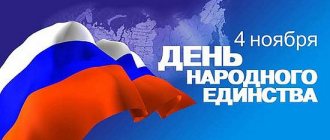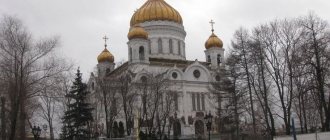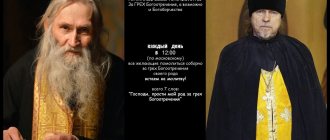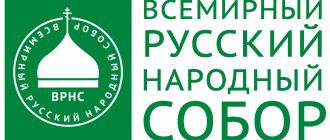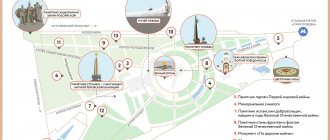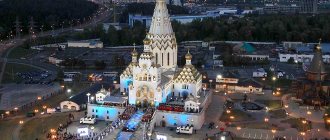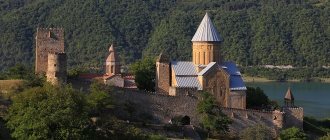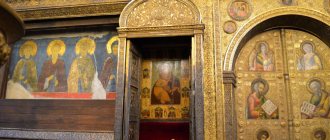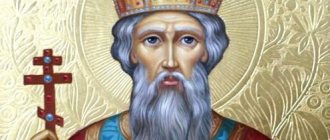On National Unity Day, November 4, 2021, a solemn ceremony was held in Moscow to mark the opening of the monument to Saint Equal-to-the-Apostles Prince Vladimir.
The monument can be called, in the full sense, a national one; it was created with funds from the Russian Military Historical Society and private donations. In total, more than 100 million rubles were collected.
The monument to Vladimir was erected on Borovitsky Hill, its height together with the pedestal is 17.5 meters. The sculpture is made of bronze, the pedestal is made of granite, the authors of the project are artist Salavat Shcherbakov and sculptor Igor Voskresensky.
It should be noted that initially the public and experts had concerns that the figure of Prince Vladimir would become similar to Peter the Great, made by Tsereteli, on the Crimean embankment. It is possible that it was precisely because of these doubts that the previously planned height of 24 meters was significantly reduced.
Although the monument turned out to be tall, it successfully blended into the surrounding space without overwhelming other Moscow sights near the Kremlin.
According to most historians and ordinary townspeople, the monument to Vladimir was a success. When creating it, the authors did not want the monument to look like an icon, and therefore the bronze prince they created is not only a saint, but also a warrior and politician. He is a calm and strong, courageous and self-confident ruler and warrior.
Three bas-reliefs tell us about the life and deeds of the prince. These are real sculptural paintings. The first of them glorifies Prince Vladimir as the ruler and builder of Russian cities. On the second bas-relief we see the baptism of Vladimir and on the third the baptism of Rus' is depicted.
History of creation
The decision to create a monument to Vladimir was made at the beginning of 2015. That year marked 1000 years since the death of the prince. They did not have time to build a monument for this memorable date, but a memorial sign was erected, the foundation stone of which was consecrated by Patriarch Kirill.
Initially, it was planned to erect the sculpture on Sparrow Hills, which caused a sharp protest from the public. Moreover, the geological situation did not allow this to be done.
To take into account the opinion of Muscovites, the construction site was chosen by voting in the Active Citizen mobile application. Of the three proposed options (Borovitskaya, Lubyanka Square or Zaryadye Park), the first option received the most votes. UNESCO was also not against this decision.
Negative character
Prince Vladimir Krasno Solnyshko is the son of the Kyiv prince Svyatoslav Igorevich from the Rurik family and the daughter of the Drevlyan prince Malusha. He was born far from the capital city, but was soon reclaimed by Princess Olga and returned to his father’s homeland. He was the heir of Novgorod, which Svyatoslav gave him ownership before his disastrous campaign.
The first period of growing up in the reign of Vladimir was barbaric and bloody: the insidious and bloody murder of Yaropolk’s brother and the father and brothers of his wife Rogneda, complete violence against Rogneda for the sake of a forced marriage, the forcible taking of the murdered Yaropolk’s pregnant wife—a former Greek nun—as a concubine, and other atrocities .
And in religion, Vladimir was initially not only an ardent pagan. It is assumed that he actively used bloody human sacrifices to idols and gods.
Making a monument
The casting of the sculpture elements was carried out at a foundry in Khimki, and the right hand and cross were cast separately from the figure of the prince. In total, the creation of the monument took 25 tons of bronze and the same amount of steel to make the internal frame, inside of which a technical staircase is reinforced.
To transport the monument on a tractor, a special 20-ton structure was built. A special frame was built on Borovitskaya Square, inside of which the monument was installed using a 500-ton crane. Then industrial climbers performed welding work for two weeks.
Vladimir and the Baptism of Rus'
At that time, the Kiev prince was sick with a strange eye disease, from which doctors could not save him. Anna insisted on urgent baptism. During the ceremony, Vladimir’s illness was miraculously healed. From that moment on, other Russians began to be baptized into the new faith. And upon the arrival of the newlyweds in Kyiv, by decree of Prince Vladimir, all idols were thrown into the Dnieper, and the majority of the city’s population was baptized in the waters of the river. The prince himself refused polygamy, leaving his only wife near him - Anna.
About Prince Vladimir
Prince Vladimir went down in history as the collector of Russian lands. He strengthened the Russian state with all his might and ways. Having made a series of campaigns to the west and east against the Khazars and Yatvingians, Poles and Volga Bulgarians, he managed to subjugate many new territories to the Russian state. Rus' has become a power playing an important role in world politics.
Prince Vladimir is known as the baptist of Rus'. Regarding the choice of faith, a legend has been preserved, according to which the prince talked with representatives of different religions, but settled on Christianity.
The chronicle says that after the conquest of Korsun (Chersonese), Vladimir wished to marry the sister of the Byzantine emperors Vasily II and Constantine VIII Anna. The consent of the rulers was obtained, but on the condition that Anna had to marry a fellow believer, that is, Vladimir had to accept the Orthodox faith.
The prince and his entire retinue accepted the rite of baptism, after which the marriage took place. The date and place of these events are not precisely established, but the year of the baptism of Rus' is considered to be 988.
The monument to Vladimir in Moscow turned out to be bright and aesthetically attractive. It successfully complemented the complex of attractions of the capital located in the vicinity of the Kremlin. Time will decide one way or another. Our children and grandchildren will appreciate the monument themselves and express their opinions.
Monument to Vladimir: why the baptist of Rus' brought chaos to the ranks of Muscovites
The installation of the monument to Prince Vladimir on Borovitskaya Square in Moscow should begin on the night of October 15-16. The decision to install a 16-meter monument near the Kremlin and the famous Pashkov House in a relatively small area caused a storm of protests and controversy. Although the location of the sculpture was determined by popular vote, and was also recommended by specialized commissions and authorities, there are many in the expert community who consider this decision a mistake. What is wrong with the monument to the Baptist of Rus', and whether the “holy place” should be left empty, a RIAMO correspondent learned from the most eminent architects of the capital.
They want to erect a monument to Prince Vladimir in Moscow without the consent of UNESCO>>
Sergey Skuratov, president, board member of the Union of Moscow Architects, professor of the International Academy of Architecture, laureate of numerous Russian and international competitions and shows, Honorary Builder of the City of Moscow, author of the most expensive houses in Moscow: “Art House”, “House on Mosfilmovskaya” and other projects:
Sergey Skuratov Architects
Sergey Skuratov Architects
Sergey Skuratov Architects
1 of 3
“It is very difficult, and even unprofessional, to talk about a monument when you have not seen it in person. Conclusions based on pictures seen on the Internet, without understanding the size, proportions, plasticity and composition of the figure itself seem to me extremely unproductive and make no sense. Therefore, I will limit myself to only analyzing the place where the monument is supposed to be erected.
In my professional opinion, this place is extremely unfortunate and generally unprofitable for the installation of any monument, regardless of its size, function and political significance. This is a transit space with heavy vehicle traffic all hours of the day. The point at which the monument will stand will always be compositionally inferior to the main building in this space - the Pashkov House. From the point of view of the logic of installing a monument, this is wrong.
The perception of the monument will always be blurred by noise, traffic flow and isolation from the main pedestrian flows of the central part of the city in the spaces surrounding the Kremlin.
The spectators of this monument will be mainly motorists, who, excuse me, have no time to look at this place, since they need to quickly change lanes when leaving the bridge and entering the square from the embankment. There are very few people crossing the bridge. In my opinion, such a monument would be appropriate, for example, inside the Kremlin, where there is a certain atmosphere of calm and purposeful acquaintance with historical monuments.
From a purely artistic point of view, it seems to me that linking the size and scale of a monument or landmark with the “size” of its historical authority is an extremely outdated principle, long gone in many cultures. The artistic component is always more valuable than the dimensions.
The Orthodox Church approves the idea of installing a monument to Prince Vladimir in Moscow>>
The scale of the monuments on Mamayev Kurgan, Sapun Mountain, and in the Kursk Bulge region is a thing of the past. They are symbols of their era. A return to such gigantomania cannot but cause concern.
You have to wait for the installation and see everything with your own eyes. But if the majority of professional opinions are different from laudatory ones, it seems to me that it would be more correct to listen to them. The wisdom and strength of those people who make decisions in life is to admit their mistakes and correct them, and not to pretend that nothing is happening. This answer of theirs will be regarded as a victory of common sense over momentary circumstances."
Sergey Tkachenko , Honored Architect of the Russian Federation, Corresponding Member of the Russian Academy of Arts, ex-head of the Research and Design Institute of the General Plan of Moscow, author of such famous objects in Moscow as the “Egg House” on Mashkova Street, the Patriarch, “Copernicus” and “Garden” residential complex labyrinth":
website of the Russian Academy of Arts
Russian Academy of Arts
Russian Academy of Arts
Russian Academy of Arts
1 of 4
“There are iconic monuments for any era. For example, the atmosphere of Moscow in the 90s is embodied in the monument to Peter I. Now it has turned into a kind of attraction, foreign tourists willingly take pictures against its background and perceive it as some kind of miracle in Moscow. Only the lazy did not scold the monument: its size, style of execution, and many mistakes made caused a lot of ridicule. However, it is obvious that the sculpture of Peter became a symbol of that time.
The monument to Prince Vladimir is also significant and may well become a symbol of our time.
The monument itself was made professionally. Its artistic merits do not raise any questions in my mind, but they lose all significance against the background of choosing a place for its installation. In my opinion, the decision to place it on Borovitskaya Square is a sign of our era. It clearly demonstrates the authorities’ complete disregard for public opinion. There is a solution, and that means it will be implemented, despite any arguments and objections.”
Dmitry Shvidkovsky, rector of the Moscow Architectural Institute, member of the Council for Culture and Art under the President of the Russian Federation, member of the Commission on Monumental Art of the Moscow City Duma, vice-president of the Russian Academy of Arts, academician of the RAASN, Honored Artist of the Russian Federation, laureate of the State Prize of the Russian Federation, holder of the Order of Honor:
Russian Academy of Arts
“Active discussions around a decision that has already been made seem unnecessary to me. Preparatory work is underway at the installation site; installation of some parts of the monument has already begun. We must not forget that the issue was discussed for a very long time: a vote was held among Muscovites, meetings of experts, including historians, architects, artists, and art critics; the recommendations of the Ministry of Culture of the Russian Federation, the Department of Cultural Heritage of Moscow, as well as the Committee on Architecture and Urban Planning of the capital were taken into account. As a result of all these procedures, the Commission on Monumental Art under the Moscow City Duma proposed to approve Borovitskaya Square as the location for the installation of the monument to Prince Vladimir.
RVIO collected 94 million rubles necessary for the installation of a monument to Prince Vladimir in Moscow>>
This was not a spontaneous decision made by one official; behind it there were many stages of coordination with the participation of many authorities and specialists.
In my opinion, nothing bad is happening. The overall appearance of the space does not suffer. The dimensions of the sculpture itself are not so monumental that it could compete with the Pashkov House or the Kremlin for its dominant role in the overall ensemble of the square. I don't see any threat in this regard.
Moreover, many solutions were considered for the space of Borovitskaya Square, among which were projects with the development of this territory with buildings and other structures. As a result, preference was given to the monument to Vladimir and the park. The option of installing the monument on the square even protects it from the construction of objects that would disrupt the panoramic function and threaten its historical significance.
As for the threat to the UNESCO World Heritage Site “Moscow Kremlin and Red Square”, the possible loss of historical value and status, these are just assumptions of some experts. I am sure that they will not find confirmation and will not be supported by any real UNESCO prohibitions. Personally, I have not seen any documents from UNESCO confirming these concerns.”
Irina Irbitskaya, director of the Center for Urban Planning Competence of the Institute of Social Sciences (ION) RANEPA, advisor to the Union of Russian Architects, member of the Union of Moscow Architects (SMA), member of RUPA (Association of Urban Planning Documentation Developers), co-founder and member of the Guild of Architects and Engineers, member of the international and national jury urban planning and architectural competitions, laureate of international and national awards in the field of architecture and urban planning:
personal page on facebook
I believe that the installation of a monument to Prince Vladimir on Borovitskaya Square is a completely unreasonable and erroneous decision. This place is significant for the capital, and in no case should its role as a historical panorama for the Pashkov house and the ensemble of the Moscow Kremlin be distorted.
The height of the monument to Prince Vladimir in the center of Moscow will be 16 meters>>
To erect a useless monument on such an iconic place, the artistic value of which has yet to be proven, is a catastrophic mistake.
All arguments in favor of the fact that the construction of a monument is an organic improvement of a given territory, without compromising the overall appearance of the space, are meaningless. The monument is not protection from other buildings, but a threat to the historical value of the square, belittling its role and significance. There should be nothing here, Borovitskaya Square should retain its panoramic function and serve as a stage for viewing such indisputable masterpieces of world architecture as the Pashkov House and the Kremlin. Resolving such issues should not turn into a choice of the lesser evil; it should be a logical continuation of city policy.”
The Patriarch consecrated the foundation stone at the site of the monument to Prince Vladimir in Moscow>>
Fictional symbol of unity
With the monument to the Kyiv prince Vladimir Svyatoslavich, who went down in history under the nickname the Great, the creation of the myth began that this figure acted as a collector of Russian lands. On this basis, the president began to declare that Russia, and not Ukraine, is the continuer of the traditions of Kievan Rus.
Neither historians nor Putin himself can provide convincing arguments. Everything is limited to loud statements, which are now supported by the monument to Vladimir on Borovitskaya Square in Moscow.
The monument project at the development stage has caused a mixed reaction from the public. The monument was first planned to be erected in 2015, to coincide with the 1000th anniversary of the death of Vladimir. A specific date was also named - November 4. This day in the Russian calendar since 2005 has been a public holiday dedicated to Unity Day. The history of the event is connected with 1612, when the inhabitants of Moscow expelled the Polish army from the city, which brought Mikhail Romanov to the throne and the founding of the Romanov dynasty.
The desire to erect a monument to Vladimir the Baptist in the capital was expressed by representatives of the Russian Military Historical Society and the Moscow authorities, who published on February 11, 2015 information about the already held competition for the best design of the monument. The message said that a commission headed by Bishop Tikhon reviewed 10 projects and then chose the winner by secret ballot. It became the workshop of the People's Artist of the Russian Federation Salavat Shcherbakov.
Positive character
After baptism, Vladimir Svyatoslavich began to lead a virtuous lifestyle. The aggressive campaigns of the Russian army against neighboring tribes and states stopped. The Prince of Kiev began to care primarily about educating the people. They opened colleges and schools, built churches, developed charity: the poor could find shelter, food and financial support in the princely court, and those who could not leave the house were supplied with food supplies by decree of the prince. In his mercy, Prince Vladimir sometimes even went too far. For example, the death penalty for criminals was replaced by a cash ransom. Too soft an attitude towards Novgorod led to the fact that the Novgorodians disobeyed, refused to pay tribute to Kyiv and demanded freedom. Shortly before his death, Vladimir the Saint made another big political mistake - he divided the lands for inheritance between his sons, thereby dooming the Fatherland to a time of internecine wars.
Baptist of Rus'
Vladimir went down in history as the conqueror of new territories for the Russian state. Having undertaken several campaigns against the Khazars, Poles, and Volga Bulgars, he changed the balance of power on the political horizon and achieved the transformation of the country into a powerful power. After the conquest of Chersonesus, Vladimir married a representative of the Byzantine imperial family, Anna. One of the conditions of this marriage was the adoption of the Orthodox faith by the Russian prince and his squad. So says the legend - the most plausible of all that are associated with Vladimir’s choice of Christianity. Rus' joined Byzantine culture and raised its international authority.
The area around the monument
With the installation of the monument to Vladimir, Borovitskaya Square changed its appearance.
The sculpture is installed in the center of a historical hill and fenced off by trees from residential buildings. From the side of the Alexander Garden, gentle steps lead to it, which fan out below, reminiscent of waves from a person entering the water. This is an allegory of the baptism of Russian people in the Dnieper water. And near the Alexander Garden, the steps resemble a pointed wing as an angelic symbol of heavenly grace and heavenly powers. Near the monument, electric artistic lighting is turned on, focusing attention on its figure even in the dark.
Characteristics of the monument
The height of the monument is 17.5 meters. The figure of the prince is made in full height. Vladimir was dressed in a cloak embroidered with patterns and a princely hat, holding a cross in his right hand, which stood nearby. In the left hand there is a sword, the tip of which is turned towards the ground. This is a symbol about the events that preceded the adoption of Christianity.
According to the generally accepted version, the prince decided to be baptized after the Byzantine emperors Vasily and Constantine agreed to give Vladimir his sister Anna as his wife. After this, the Kiev prince removed the obloga of Korsun (Chersonese). In honor of such an event, Vladimir allegedly lowered his blade.
The authors of the monument made the prince’s face stern and his gaze open and direct. For some reason, Russian historians believe that this is exactly how the prince should have looked at the people with whom he fought because of the worship of pagan idols. Therefore, historians declare that the monument to Vladimir in Kyiv with a soft and meek face, with a hat in his hand, and not a sword, is a fiction. Such a prince could not be, because he had to have fearlessness in order to introduce Christianity.
Such assumptions have no historical basis or evidence. On the contrary, Ukrainian historians, relying on Byzantine chronicles, substantiated the thesis that after Christianization, Vladimir, his entourage, and the population of Kievan Rus adhered to many pagan rituals for many years. The prince himself had a harem of concubines, which is prohibited by Christianity, but permitted by other beliefs.
Thus, Vladimir was not the example of spirituality and morality that official Russian science presents him with. Although it was precisely these qualities that President Putin called for at the opening of the monument.
Discovery and statements by authorities
On November 3, 2015, the Patriarch of the Russian Orthodox Church consecrated the first foundation stone on the site where the monument was later erected. On October 15, the sculpture was delivered to Borovitskaya Square on October 15, installation began on October 16, 2021. Assembly continued until the 20th, opening on November 4, 2021.
The ceremony was attended by President Vladimir Putin, Prime Minister Dmitry Medvedev, Patriarch Kirill of Moscow, Moscow Mayor Sergei Sobyanin and other government officials.
Speaking after the opening of the monument, Putin said that Vladimir was the collector of Russian lands, the founder of the Russian state, the great ancestor of the Russian people. Patriarch Kirill, during the consecration of the sculpture, constantly emphasized that all the peoples of historical Rus' must unite. Kirill also stated that the monument is a symbol of the unification of the peoples of which he was the father. The Patriarch believed that a monument to such a “father” could stand anywhere, so that the “children” would not forget their “father.”
How to get there
Take the metro to the Borovitskaya station. You can take buses No. M1, M3, MB, N11 and 144, get off at the Lenin Library stop.
Sights of Moscow
Category: Moscow
On November 4, 2021, on the holiday of National Unity Day, the opening of a monument to Prince Vladimir took place in Moscow. A bright and aesthetically perfect sculptural complex adorned Borovitskaya Square and the surrounding area of the Kremlin. The monument can rightfully be called a people's monument, since over 100 million rubles of voluntary donations were collected for its construction. This money became a significant addition to the funds allocated by the Russian Military Historical Society for the creation of the monument.
